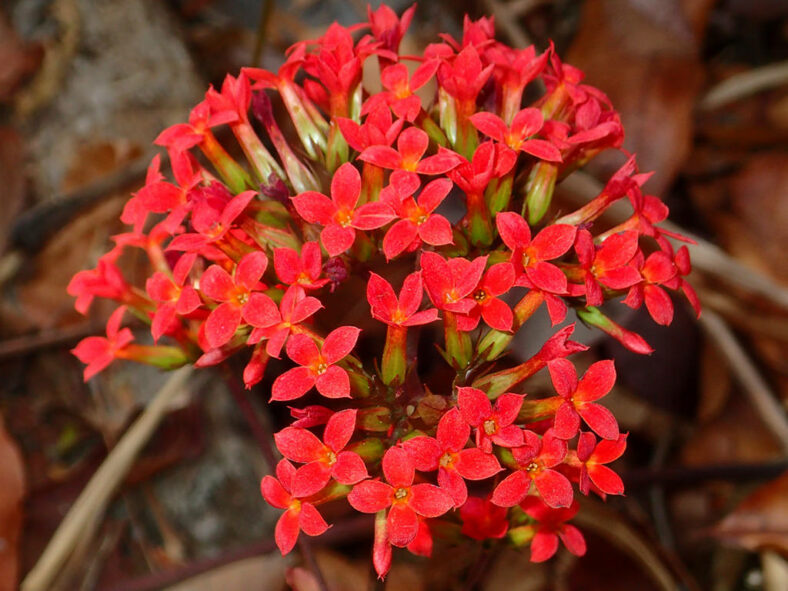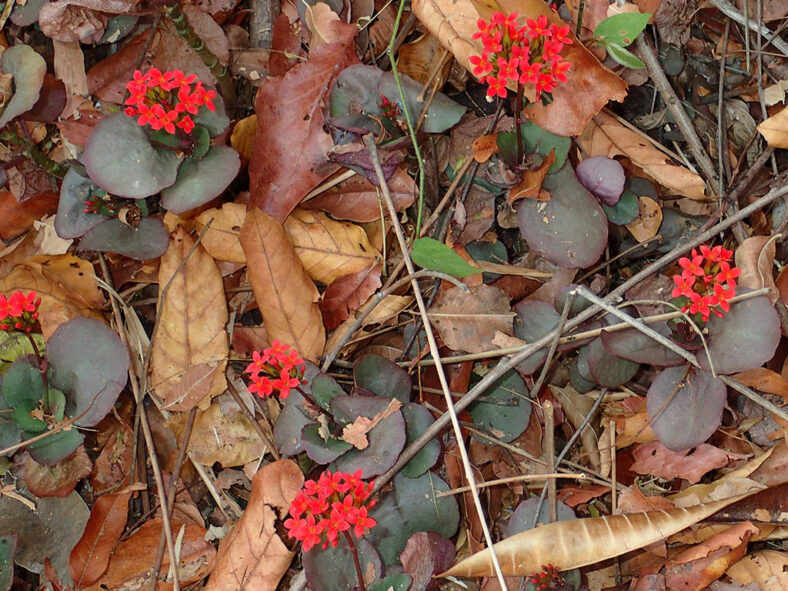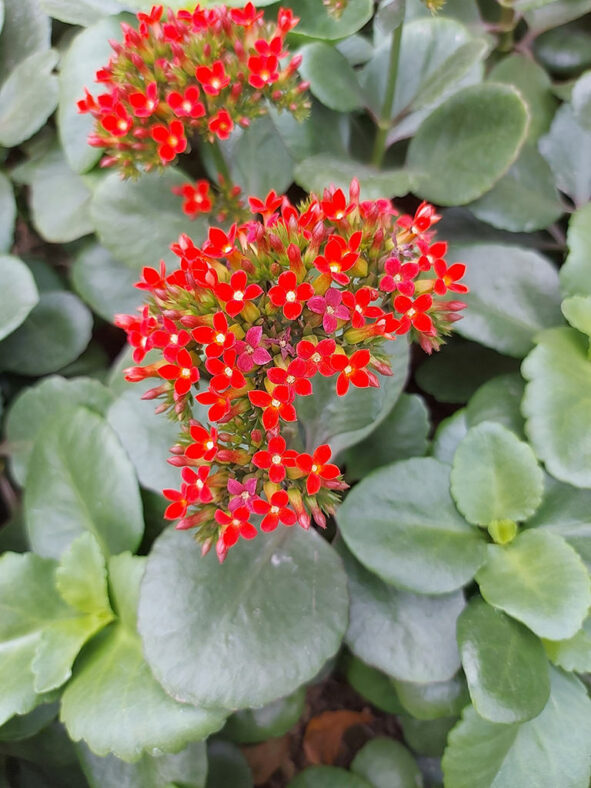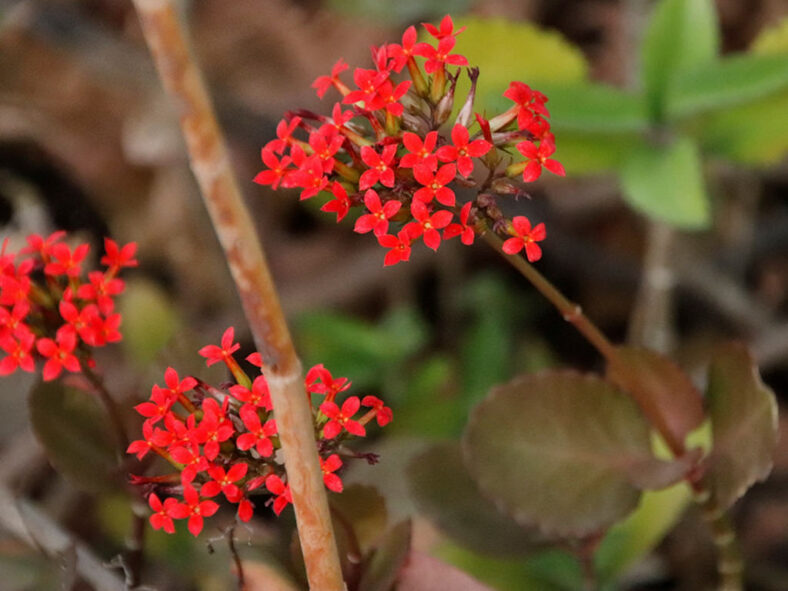Kalanchoe blossfeldiana is a highly popular species that was introduced around 1930. It has since grown because of its ease of cultivation and brilliant flowers. This species is a recipient of the prestigious Award of Garden Merit of the UK's Royal Horticultural Society. Over the years, horticulturists have developed numerous cultivars with a wide range of flower colors, including nearly all colors except black and blue.
Scientific Name
Kalanchoe blossfeldiana Poelln.
Common Name(s)
Christmas Kalanchoe, Flaming Katy, Florist Kalanchoe, Madagascar Widow's Thrill
Synonym(s)
Kalanchoe coccinea var. blossfeldiana
Scientific Classification
Family: Crassulaceae
Subfamily: Sedoideae
Tribe: Kalanchoeae
Genus: Kalanchoe
Etymology
The specific epithet "blossfeldiana" (pronounced "bloss-fel-dee-AY-nuh") honors Robert Blossfeld (1882-1945), a German hybridiser and botanist who first introduced the species to the rest of the world in 1932.
Origin
Kalanchoe blossfeldiana is native to Madagascar. It grows at elevations ranging from 5,250 to 7,870 feet (1,600 to 2,400 m) in humid cloud forests of the Tsaratanana Mountains.
Description
Kalanchoe blossfeldiana is a succulent shrublet with upright to slightly leaning branches that bear fleshy leaves with scalloped margins in the upper half. It can grow up to 16 inches (40 cm) tall. The stems are green to reddish-green, round in cross-section, and rarely have one or two lengthwise running ridges. The leaves are elliptic to ovate or oblong–spatulate, measuring up to 2.8 inches (7 cm) long and 1.6 inches (4 cm) broad. They are arranged at right angles to the pair below and above them and are attached to the stems by a petiole, which can be up to 1 inch (2.5 cm) long. The leaves are dark green, shiny, and often have red edges.
The fragrant flowers are erect and have a green to reddish-green calyx and a crimson red to scarlet corolla with spreading lobes. They appear in dense, many-flowered clusters in winter and can last for many weeks. The plant can be manipulated to flower at any time of year. The fruits are brittle, dull, whitish-green follicles that contain light brown seeds.

Cultivars of Kalanchoe blossfeldiana
How to Grow and Care for Kalanchoe blossfeldiana
Light: Kalanchoe blossfeldiana grows best in full sun but usually appreciates some partial shade during the hot summer days. When growing indoors, place it near a window with indirect sunlight. If it does not receive enough light, it may stretch.
Soil: The plant needs soil that drains well and does not like "wet feet." A commercial potting mix for succulents will work well.
Temperature: Kalanchoe blossfeldiana thrives in warm temperatures and high humidity, but cannot tolerate frost. It grows best in USDA Plant Hardiness Zones 10a to 11b, with average minimum winter temperatures ranging from 30°F to 50°F (-1.1°C to 10°C).
Watering: From spring to fall, water the plant thoroughly, but allow the soil to dry out between waterings. Overwatering can cause stem rot. Reduce water during winter and only water it enough to prevent the leaves from shriveling.
Fertilizing: Fertilize the plants occasionally during the growing season with a balanced fertilizer diluted to half or quarter strength, and apply it every two weeks.
Repotting: The plant thrives better when frequently repotted. For optimum growth, repot it every two years in spring. Go up one pot size every time you repot.
Propagation: Kalanchoe blossfeldiana can be easily propagated by seeds, leaves, and stem cuttings. Spring is the best time to take cuttings, while spring and summer are ideal for sowing the seeds.
Learn more at How to Grow and Care for Kalanchoe.
Toxicity of Kalanchoe blossfeldiana
Kalanchoe blossfeldiana is not toxic to humans, but it should be kept away from pets, as ingestion may cause vomiting, diarrhea, and heart arrhythmias.
Links
- Back to genus Kalanchoe
- Succupedia: Browse succulents by Scientific Name, Common Name, Genus, Family, USDA Hardiness Zone, Origin, or cacti by Genus
Photo Gallery
Click on a photo to see a larger version.


